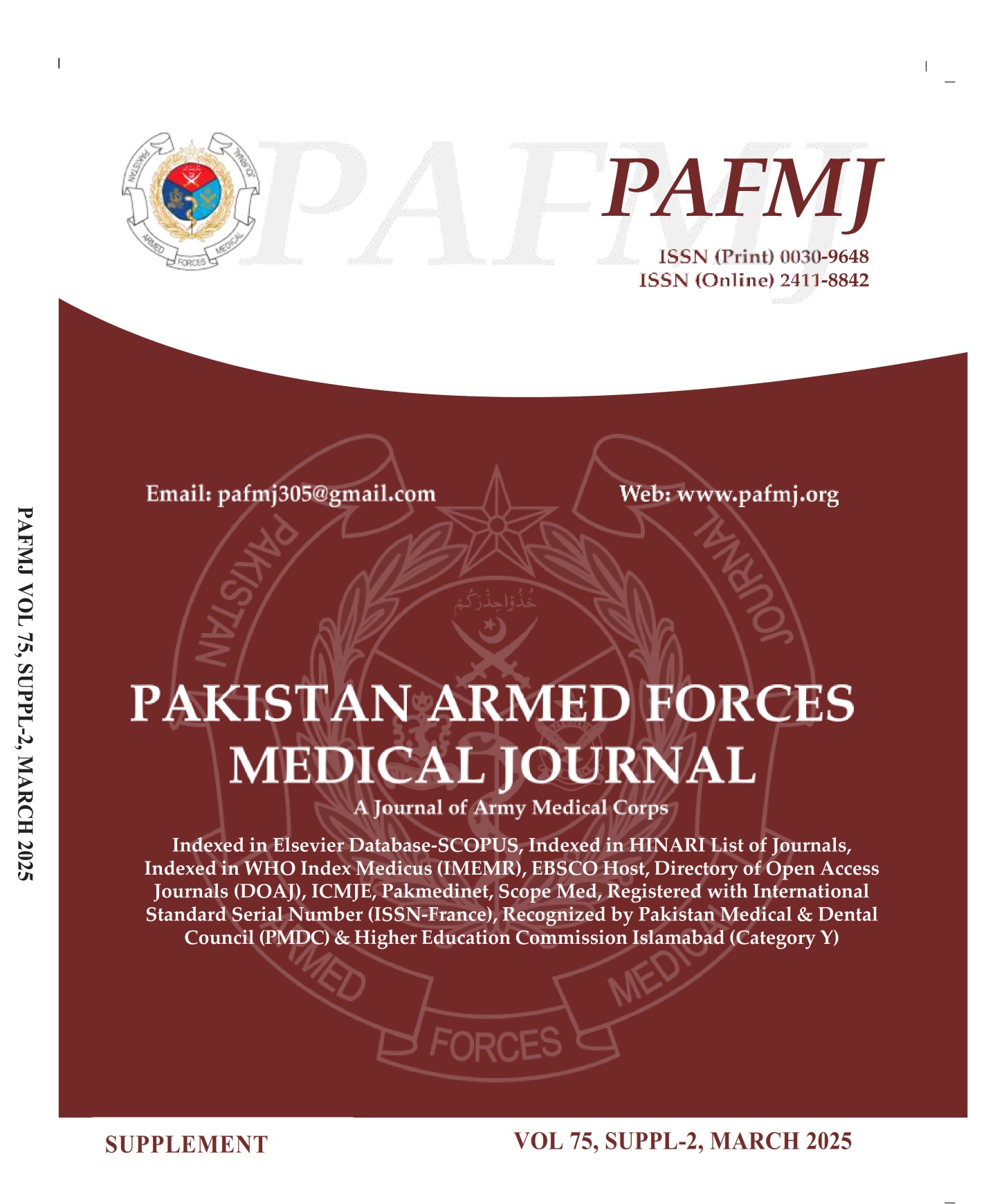Comparison of Risk Factors in Patients With and Without Early Post-Operative Complications After Hepaticojejunostomy for Iatrogenic Bile Duct Injury
DOI:
https://doi.org/10.51253/pafmj.v75iSUPPL-2.9672Keywords:
Bile duct injury, Comparison, Hepaticojejunostomy, Risk Factors.Abstract
Objective: To analyze the risk factors associated with early post-operative complications among patients undergoing hepaticojejunostomy for iatrogenic bile duct injury.
Study Design: Comparative Cross-sectional Study.
Place and Duration of Study: Army Liver Transplant Unit, Rawalpindi Pakistan, From Jan to Oct 2022.
Methodology: Eighty-one patients who underwent different types of hepatobiliary surgeries, had iatrogenic bile duct injury and underwent hepaticojejunostomy for repair. Patients were followed up for couple of weeks after the corrective procedure to look for various early post-operative complications. A comparison was performed for different sociodemographic factors in patients with and without early postoperative complications who were recruited in this study.
Results: Fifty-five (67.9%) patients were male and 26(32.1%) were female. Median age of patients put who underwent hepaticojejunostomy for repair of iatrogenic bile duct injury in our study was 45 years with IQR range of 40. Patients were divided into two groups on basis of presence of complications. 13(16.1%) patients had one or more complications early on after the surgery while 68(83.9%) patients had smooth early postoperative recovery without complications. Advanced age and presence of comorbid illness were the risk factors found more in groups of patients with presence of early post-operative complications (p-value<0.05).
Conclusion: Early post-operative complications were not uncommon after hepaticojejunostomy procedure opted for repair of iatrogenic bile injuries. Patients who were more than 50 years of age and had comorbid medical illnesses were more at risk of early post-operative complications in our study.
Downloads
References
Vitale A, Lai Q. New trends and perspectives in hepatobiliary surgery: preface. Transl Gastroenterol Hepatol 2018; 3: 99. https://doi.org/10.21037/tgh.2018.11.06
Amreek F, Hussain SZM, Mnagi MH, Rizwan A. Retrospective Analysis of Complications Associated with Laparoscopic Cholecystectomy for Symptomatic Gallstones. Cureus 2019; 11(7): e5152. https://doi.org/10.7759/cureus.5152
Renz BW, Bösch F, Angele MK. Bile Duct Injury after Cholecystectomy: Surgical Therapy. Visc Med 2017; 33(3): 184-190. https://doi.org/10.1159/000471818
Kapoor VK. Bile duct injury during cholecystectomy. Rozhl Chir 2015; 94(8): 312-315.
Sharma S, Behari A, Shukla R, Dasari M, Kapoor VK. Bile duct injury during laparoscopic cholecystectomy: An Indian e-survey. Ann Hepatobiliary Pancreat Surg 2020; 24(4): 469-476.
https://doi.org/10.14701/ahbps.2020.24.4.469
Pesce A, Palmucci S, La Greca G, Puleo S. Iatrogenic bile duct injury: impact and management challenges. Clin Exp Gastroenterol 2019; 12(3): 121-128.
https://doi.org/10.2147/CEG.S169492
Moris D, Papalampros A, Vailas M, Petrou A, Kontos M, Felekouras E. The Hepaticojejunostomy Technique with Intra-Anastomotic Stent in Biliary Diseases and Its Evolution throughout the Years: A Technical Analysis. Gastroenterol Res Pract 2016; 2016(3): 3692096.
https://doi.org/10.1155/2016/3692096
A European-African HepatoPancreatoBiliary Association (E-AHPBA) Research Collaborative Study management group; Other members of the European-African HepatoPancreatoBiliary Association Research Collaborative. Post cholecystectomy bile duct injury: early, intermediate or late repair with hepaticojejunostomy - an E-AHPBA multi-center study. HPB (Oxford) 2019; 21(12): 1641-1647.
https://doi.org/10.1016/j.hpb.2019.04.003
Ismael HM, Cox S, Cooper A, Narula N, Aloia T. The morbidity and mortality of hepaticojejunostomies for complex bile duct injuries: a multi-institutional analysis of risk factors and outcomes using NSQIP. Hepat Pancreat Bil 2017; 19(3): 352-358.
Hussain M, Khan AW, Khan MA, Muhammad S, Mehdi H, Butt O. Managing iatrogenic bile duct injuries through a multidisciplinary team approach: A SIUT case series. J Pak Med Assoc 2019; 69(10): 1559-1564.
Otto W, Sierdziński J, Smaga J, Kornasiewicz O, Dudek K, Zieniewicz K. Actuarial Patency Rates of Hepatico-Jejunal Anastomosis after Repair of Bile Duct Injury at a Reference Center. J Clin Med 2022; 11(12): 3396.
https://doi.org/10.3390/jcm11123396
De'angelis N, Catena F, Memeo R, Coccolini F, Martínez-Pérez A, Romeo OM, et al. 2020 WSES guidelines for the detection and management of bile duct injury during cholecystectomy. World J Emerg Surg 2021; 16(1): 30.
https://doi.org/10.1186/s13017-021-00369-w
Tekant Y, Serin KR, İbiş AC, Ekiz F, Baygül A, Özden İ. Surgical reconstruction of major bile duct injuries: Long-term results and risk factors for restenosis. Surgeon 2022; S1479-666X(22)00052-X.
https://doi.org/10.1016/j.surge.2022.03.003
Antolovic D, Koch M, Galindo L, Wolff S, Music E, Kienle P et al. Hepaticojejunostomy--analysis of risk factors for postoperative bile leaks and surgical complications. J Gastrointest Surg 2007; 11(5): 555-561.
https://doi.org/10.1007/s11605-007-0166-3
Popa C, Schlanger D, Zaharie F, Graur F, Mois E et al. A retrospective analysis of bile duct injuries treated in a tertiary center: the utility of a universal classification-the ATOM classification [published online ahead of print, 2022 Aug 10]. Surg Endosc 2022; 10(3): 459.
https://doi.org/10.1007/s00464-022-09497-z
Stilling NM, Fristrup C, Wettergren A, Ugianskis A, Nygaard J, Holte K et al. Long-term outcome after early repair of iatrogenic bile duct injury. A national Danish multicentre study. Hepat Pancreat bil 2015; 17(4): 394-400.
Downloads
Published
Issue
Section
License
Copyright (c) 2025 Basit Ali Cheema, Muhammad Qasim Butt, Nayab Mustansar, Abdul Rehman, Waqas Farooq Alvi, Muhammad Shahzad

This work is licensed under a Creative Commons Attribution-NonCommercial 4.0 International License.















